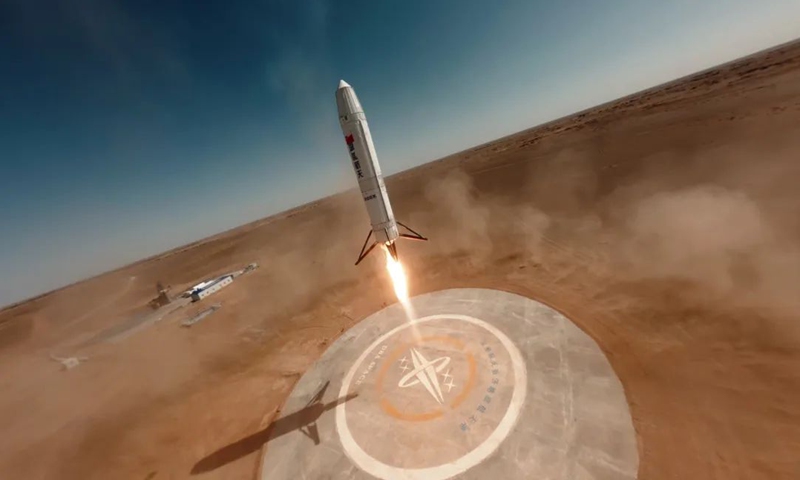
Photo: Deep Blue Aerospace
Soon after the pre-sale event of a suborbital space travel scheduled for 2027 by a Chinese commercial aerospace start-up
triggered intense discussions online, the firm revealed to the Global Times on Wednesday that one of the buyers of the two tickets is a computer engineer, and the 1.5-million-yuan ($210,900) price of the ticket they sold is quite competitive compared with international peers.
The two passengers will be traveling in a suborbital manned spacecraft via the company's reusable carrier rocket Nebula-1 to cross the Kármán line and enter the edge of space, with the entire flight time lasting about 12 minutes, according to Deep Blue Aerospace.
The company revealed that one of the buyers is a computer engineer with a passion for the universe, with no further details disclosed.
The company has taken the lead in developing Chinese reusable rockets over the years. The launch vehicle Nebula-1 that will be used to send humans into space
made its first high-altitude vertical recovery flight test in September. However, it was not completely successful after an anomaly occurred in the final landing phase.
Another flight test for the vehicle is scheduled in November. The company aims to achieve orbital flight recovery of the rocket in the first quarter of 2025.
After conducting multiple recovery and reuse tests with Nebula-1, Deep Blue Aerospace plans to carry out dozens of tests on the combination of spacecraft and rocket in 2026. Currently, the manned spacecraft is still in its research and development phase.
The Global Times learned that while the ticket price for the round trip was originally set at 1.5 million yuan per ticket, Huo Liang, the founder and chairman of the company, offered a 500,000-yuan discount during the pre-sale livestream, bringing the ticket price down to only 1 million yuan.
A spokesperson with the company said that while the price is relatively high within the domestic commercial space tourism market, it is quite competitive compared with international peers, ranking at a medium level. For instance, Virgin Galactic and Blue Origin have set higher ticket prices, while SpaceX's space travel prices vary based on different service offerings and flight durations.
Replying to a query regarding the considerations for choosing the time of 2027, the spokesperson said that from a technical perspective, by then their relevant technologies are expected to reach a level of maturity that meets the demands of commercial space tourism. This includes the reliability of rockets, the safety of spacecraft and the improvement of emergency escape systems.
From a market perspective, with the rapid development of the global commercial space market and the growing public interest in space travel, 2027 is seen as an appropriate window to launch these services.
To ensure the safety of passengers, there will be a series of measures in place. For example, advanced rocket and spacecraft technologies will be employed to ensure stability and reliability during the flight, along with an emergency escape system to protect passengers in critical situations.
Meanwhile, passengers will receive professional training on flight operations and emergency procedures to enhance their response capabilities. They will also undergo strict health checks in advance, and have their vital signs and health status monitored in real-time during the flight.
Space tourism places relatively high physical requirements for passengers as they will face a number of challenges during the flight. The weightless environment of space may cause physical discomfort, and during the rocket launch and return phase passengers may experience significant acceleration and deceleration, requiring them to endure certain physical stresses. Furthermore, the radiation in space could pose health risks to passengers, necessitating appropriate protective measures.
Therefore, the passengers need to be in good health without serious heart issues, blood pressure problems or epilepsy. Additionally, their height and weight must fall within specific ranges to accommodate the design and flight requirements of the spacecraft, the spokesperson of the company said.




